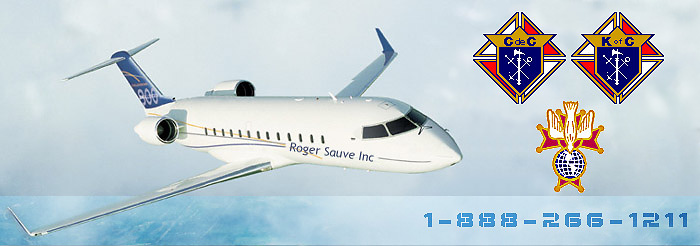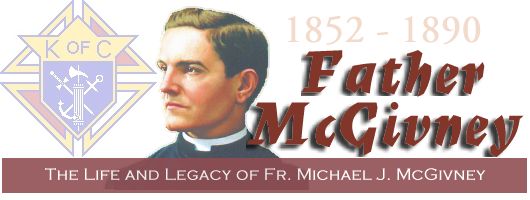Ontario State Council
Knights of Columbus
-
History
How Father McGivney first formed the Knights of Columbus. -
History In Canada
Father McGivney brings the order to Canada. -
History In Ontario
The beginnings of the Knights of Columbus in Ontario State. -
How to Join!
How to Join, Member benefits and why you should join the Knights -
Emblems of the Order
History of the K of C emblem as well as the 4th degree emblem
History
On Oct. 2, 1881, a group of men met in the basement of St. Mary’s Church on Hillhouse Avenue in New Haven, Connecticut. Called together by their 29-year-old parish priest, Father Michael J. McGivney, these men formed a fraternal society that would one day become the world’s largest Catholic family fraternal service organization.
They sought strength in solidarity, and security through unity of purpose and devotion to a holy cause: they vowed to be defenders of their country, their families and their faith.
These men were bound together by the ideal of Christopher Columbus, the discoverer of the Americas, the one whose hand brought Christianity to the New World. Their efforts came to fruition with the incorporation of the Knights of Columbus on March 29, 1882.
They were Knights of Columbus.
The Order has been called "the strong right arm of the Church," and has been praised by popes, presidents and other world leaders, for support of the Church, programs of evangelization and Catholic education, civic involvement and aid to those in need.
Father McGivney’s founding vision for the Order also included a life insurance program to provide for the widows and orphans of deceased members. The Order’s insurance program has expanded substantially to serve more effectively the Knights’ growing membership.
Year after year, the Knights of Columbus has earned the highest possible quality ratings for financial soundness from A.M. Best and Standard & Poor’s. The Order provides the highest quality insurance, annuity and long-term care products to its members, along with many other fraternal benefits.
The Supreme Council is the governing body of the Knights of Columbus and is responsible for the development of the organization as a whole. Supreme Council duties include establishing the Order in new regions and setting up regional authorities, defining and advancing its values and goals, undertaking organization-wide initiatives, promoting awareness of the Knights’ mission worldwide, and protecting the families of members through its extensive insurance program. Members working in local, or subordinate councils, however, carry on the majority of the Knights’ beneficial work.
The first knights of Columbus Council in Canada was formed in Montreal in
1897. For more than a century, the knights of Columbus has thrived in
Canada, and today, there are more than 229,500 Canadian members in nearly
1,900 councils throughout Canada 10
Provinces. As knights, members witness to their Catholic faith by serving
the Church and engaging in volunteer service to those in need. Canada was a
country that held special significance for Knights of Columbus founder Fr.
Michael J. McGivney. Even before the knights existed, Fr. McGivney spent
significant time in Canada as a seminarian first at St. Hyacinth College in
Quebec, and later at St. Mary s College in Montreal.
Just 15 years after the knights of Columbus was founded in New Haven, Conn,
the knights took root in Canada with the establishment of Montreal Council
No. 284 in 1897. Former Mayer of Montreal James Guerin served as the first
Grand knight, and within 12 years, the knights had established councils
throughout Canada.
In the 108 years since that first council began in Montreal, the knights of
Canada have dedicated themselves to charitable works throughout the country.
Among the most notable activities of the knights in Canada was their
establishment of Army Huts, which served as homes away from home for
Canadian troops at training bases and behind the lines during World War II.
The Knights of
Columbus in Ontario can trace their roots back to January 28, 1900, when a
class of fifty nine candidates were initiated in Ottawa Ontario, and formed
Council 485. While at that time a United States based organization, the
growth in Ontario over the next ten years occurred primarily in towns where
the railway passed through, with commercial salesmen or transient printers
bringing the news of the Order to these towns. In 1903, Kingston, Cornwall
and Peterborough added Councils, and in 1904 a State Council was formed in
Ontario with M. J. Gorman of Ottawa being elected as the first State Deputy
of our Province. By 1910, there were twenty-four Councils and over 3,500
members of the Order in Ontario.The next decade saw continued growth of
membership in the Knights, both in Councils and membership, and especially
after the war ended in 1918. However, in what was a sign of things to come,
there was a laxity of Councils filling in reports and answering letters, and
also members dues began to fall behind, with some members paying on a credit
instead of cash basis. While this growth in members continued into the early
twenties, the advent of outside attractions such as motion pictures, radio,
sporting enterprises and service clubs brought challenges to the work of the
Knights of Columbus in Ontario. Newer members joined but were not getting
involved at the Council officer level, and by 1924 the membership growth
started to turn toward losses.
Programs, however, continued to grow, and many Council’s started to have
Corporate Communions and breakfasts. With the onset of the depression in the
1930’s, membership began to decline even further, and by 1937 it had reached
the level attained by 1918, although there were 57 Councils in existence by
1940. The Text Book and Scholarship Funds, both started in the 1920’s, were
continued during the depression, but the Scholarship Fund eventually was
discontinued due to lack of interest from students. The State Convention was
reduced to a one day meeting (and remained this way until1964,) but Regional
meetings were set up in various locations throughout the year as a way to
substitute for the reduced Convention time.
Ontario was proud to host the Supreme Convention in 1936, and again in 1944
(and later in 1972 and 2001,) all in Toronto.
The ending of World War II saw the beginning of an increase in membership,
and by the end of the decade the membership was projected to reach the total
that had been achieved in 1923. The end of the war also saw the first
edition of the State Bulletin, edited by William Sheady of Guelph, who was
the Executive Secretary and Publicity Director for the Board. In 1950, State
Deputy Frank Hyde developed a competition for Councils in Ontario which
started the tradition of naming the best Council in Ontario at the annual
Convention. In 1962, the trophy was replaced by the lectern which is passed
to the winning Council each year.
The 1950’s saw a change in the way elections to the State Council were
managed. Up until 1955, no State Officer who had served in the position of
Warden had advanced to become State Deputy; James Gaffney of Hamilton became
the first. Since that time, the progression system that is in place today,
where a State Officer is elected to the position of State Warden for a two
year term, and then elected every second year to the next highest position,
until they become State Deputy.
In 1963, the first history of the Order in Ontario was published by William
Sheady, and this was updated in 1975 by PSD Vincent Kelly. Arthur Peters,
current State Deputy is working on a new edition to bring the history up to
date. 1964 saw the first ever Ontario State Curling Bonspiel take place in
Orillia, where it continues today. By 1975, there were 155 Councils in
Ontario, and in 1972 Ontario was recognized as the leading jurisdiction in
the Order for membership increases above suspensions
In January of 1973, the Ontario State Council announced that the Canadian
Arthritic and Rheumatic Society (later The Arthritis Society,) would be the
permanent principal charity project of the Knights of Columbus in Ontario,
with one major donation being made by the State Council each year toward
this organization. The proceeds for this donation came from the annual
Ontario Charities raffle, which had been started in 1950 by PSD Frank Hyde
as the Columbian Tours raffle (today, this lives on as the annual CARS
Draw.) In 1978, under the direction of PSD Frank Shine, the scope of the
raffle was changed to donate to projects only that were provincial in
nature; previous to this local projects also received funding.
In 1977, Bishop Smith of Pembroke, the longest serving Ontario State
Chaplain (26 years,) retired and was replaced by Bishop Eugene Laroque of
Cornwall. He was eventually succeeded by Bishop Plouffe of Sault Ste. Marie,
Bishop O’Brien of Pembroke, and our current State Chaplain, Bishop Paul
Marchand of Timmins. Under Bishop Larocque, the first meeting of Council
Chaplain’s was started at the annual Convention.
In 1980, recognizing the growth of the Order in Ontario, the first office
was set up at 3335 Yonge Street in Toronto. Phil Walke was hired as the
first Administrative Assistant, to be replaced in 1984 by PSD Fred Bedard,
PSD Phil Zakoor in 1990, and Rick McLauchlan in 2001. The office has also
changed locations, with the State Council purchasing a building on Warden
Avenue in 1989, moving from there to a leased space on Yorklands Boulevard
in 1999, and to our current location in Hamilton in 2003.
In 2005, the Knights of Columbus in Ontario have over 510 Councils and close
to 57,000 members. The future looks bright, and the success of the Order,
both today and in the future, is in strong hands within the membership of
Ontario.

22nd Annual State Convention, Kitchener
1925
Membership in the Knights of Columbus is open to practicing Catholic men in union with the Holy See, who are at least 18 years old. A practicing Catholic is one who lives up to the Commandments of God and the precepts of the Church. Application are available from any member of the Knights of Columbus.
Membership benefits
As a member of the Knights of Columbus you and your family enjoy many benefits, including 12 free issues annually of the Columbia magazine, the world's largest Catholic family magazine, eligibility to join the Knights of Columbus top-ranked life insurance program, and many more family and personal benefits.
Why Join the Knights of Columbus?
Imagine being part of an organization that fills your heart and your mind with the joy of giving to others and the feeling that comes with making a difference. Knights are Catholic men, 18 years of age and older, who are committed to making their community a better place, while supporting their Church. Being a Knight is more than camaraderie; it is being involved with your community; it is supporting your local Catholic Church, while enhancing your own faith; it is about protecting and enhancing your family life. Come see just what we are all about and take the first steps to enhance your personal life.
By their deeds shall you know them... We are a group of Catholic men
that get together:
*To be of service to Church and community by coming to the aid of
those most in need in society.
*To strengthen families and family life.
*To strengthen themselves and each other in the Faith.
*To be a strong pillar of support for their priests and bishops.
*To aid one another in times of hardship, sickness or death.
*To foster the spirit of patriotism by promoting responsible
citizenship, loyalty to country and the love of God.
T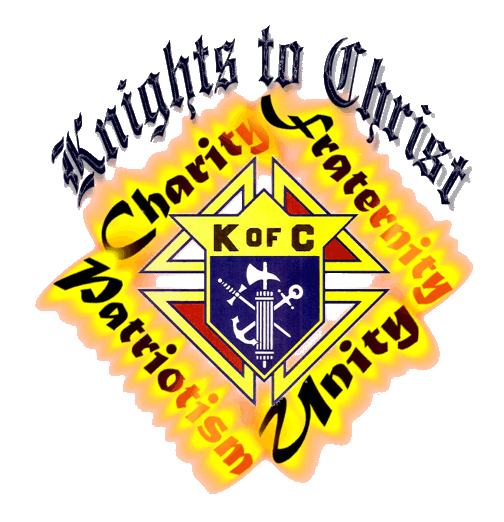
Emblem of the Order

T
he emblem indicates a shield mounted upon the Formée cross (having the arms narrow at the center and expanding toward the ends). The shield is that associated with a medieval knight. The Formée cross is the representation of a traditional artistic design of the cross of Christ through which all graces of redemption were procured for mankind. This then represents the Catholic spirit of the Order.M
ounted on the shield are three objects: a fasces (a bundle of rods bound together about an ax with the blade projecting) standing vertically and, crossed behind it, an anchor and a dagger or short sword. The fasces from Roman days, carried before magistrates as an emblem of authority, is symbolic of authority which must exist in any tightly-bonded and efficiently operating organization. The anchor is the mariner's symbol for Columbus, patron of the Order, while the short sword or dagger was the weapon of the Knight when engaged upon an errand of mercy. Thus, the shield expresses Catholic Knighthood in organized merciful action, and with the letters, K of C, it proclaims this specific form of activity.
Fourth Degree Emblem
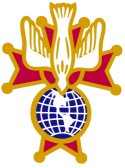
T
he triad emblem of the Fourth Degree features the dove, the cross and the globe. The dove, classic symbol of the Holy Spirit and peace, is shown hovering over the orb of the Earth (globe). Both are mounted on a variation of the Crusader's cross, which was found on the tunics and capes of the Crusading knights who battled to regain the Holy Land from the pagans.S
piritually, the sacred symbols on the emblem typify the union of the Three Divine Persons in one Godhead, the most Blessed Trinity.-
The Globe -- God the Father, Creator of the Universe.
-
The Cross -- God the Son, Redeemer of Mankind.
-
The Dove -- God the Holy Spirit, Sanctifier of Humanity.
T
he colours of the symbols are:-
A blue globe with the land of the Western Hemisphere in
white.
-
A red cross with gold borders and gold knobs at the end of
the points forming the ends of the arms of the cross, also known as the
Isabella cross.
-
A white dove.
R
ed, white and blue are the colours of the flag of the country in which the Knights originated. They are used to stress patriotism, the basic principle of the Fourth Degree.
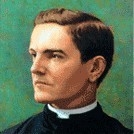
Fr. Michael J. McGivney
Formed the Knights of
Columbus
March 29, 1882
The Life and Legacy of
Fr. Michael J. McGivney
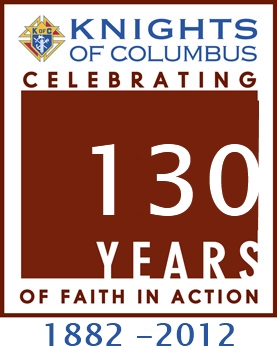
Celebrating 125 Years
2007 Marks 125 years of
unity, charity and faith.
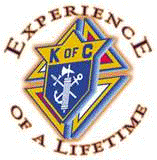
Join us
For the experience of a lifetime.







